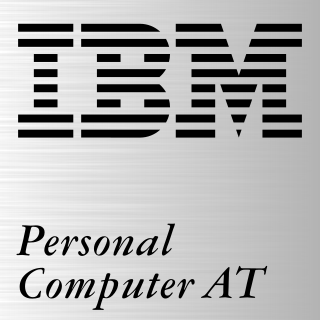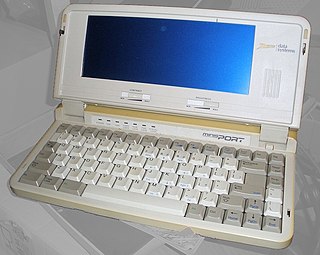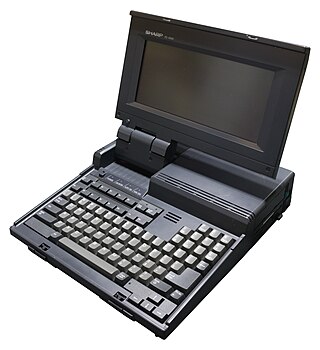
The Tandy 1400 LT is the first MS-DOS compatible laptop sold by Tandy Corporation. [1] Introduced in November 1987, it had two 3.5 inch floppy drives and a flip-up monochrome LCD screen, powered by an internal battery. [2]

The Tandy 1400 LT is the first MS-DOS compatible laptop sold by Tandy Corporation. [1] Introduced in November 1987, it had two 3.5 inch floppy drives and a flip-up monochrome LCD screen, powered by an internal battery. [2]
The 1400LT (catalog number 25-3500) had two 3.5 inch floppy diskettes with a capacity of 720 KB each. The processor was the Intel 8088–compatible NEC V20, with a clock speed of 7.16 MHz or 4.77 MHZ for compatibility with IBM PC programs. The system came with 768 KB of RAM. A socket was provided for an optional 8087 numeric coprocessor. The back-lit monochrome LCD screen had a resolution of 640 by 200 pixels and was IBM CGA compatible, mapping colors to greyscale. Text modes supported included 80 by 25 and 40 by 25. [3]
The computer came with a parallel printer port, 9-pin RS-232 serial port, and a socket for an external color monitor and a composite video output. The system also had a DIN socket to accept a PC XT-style external keyboard. Two internal slots allowed for installation of an optional internal 1200-baud modem or other devices. The system had an internal battery-backed real-time clock. [4]
The system could operate from AC power with an external adapter, which also charged the internal battery. The system could operate for about four hours on the battery, which was replaceable by the user.
The unit weighed about 13.5 lbs (5 kg) and was approximately 3.5 by 14.5 by 12.5 inches (8.9 by 36.8 by 31.8 cm) when closed. [5]
At introduction, the computer list price was US$1599. [6]
For interchange of data with desktop systems, Tandy later made available an external 5.25-inch diskette drive.
Later revised designs were the 1400 FD, which was lighter, omitted the composite video port, and had an external floppy drive connector. The 1400 HD was similar to the FD but replaced one internal floppy drive with a 20 megabyte hard drive. All members of the 1400 family were dropped from Radio Shack catalogs after 1991.
The "clamshell" configuration of the Tandy 1400 was similar to that of the earlier Data General/One and IBM PC Convertible. Although the battery life of the 1400 LT was less than that of the IBM Convertible, the system came with more standard peripheral connections and was priced significantly lower.[ citation needed ]

The Tandy 1000 is the first in a line of IBM PC compatible home computer systems produced by the Tandy Corporation for sale in its Radio Shack and Radio Shack Computer Center chains of stores. Introduced in 1984, the product line was aimed at providing affordable but capable systems for home computing or education, with some of its Tandy specific features like graphics, sound and joystick port making it more appealing for home use.

The IBM PC Convertible is a laptop computer made by IBM, first sold in April 1986. The Convertible was IBM's first laptop-style computer, following the luggable IBM Portable, and introduced the 3½-inch floppy disk format to the IBM product line. Like modern laptops, it featured power management and the ability to run from batteries.

The IBM Personal Computer AT was released in 1984 as the fourth model in the IBM Personal Computer line, following the IBM PC/XT and its IBM Portable PC variant. It was designed around the Intel 80286 microprocessor.

The Tandy 2000 is a personal computer introduced by Radio Shack in September 1983 based on the 8 MHz Intel 80186 microprocessor running MS-DOS. By comparison, the IBM PC XT used the older 4.77 MHz Intel 8088 processor, and the IBM PC/AT would later use the newer 6 MHz Intel 80286. Due to the 16-bit data bus and more efficient instruction decoding of the 80186, the Tandy 2000 ran significantly faster than other PC compatibles, and slightly faster than the PC AT. The Tandy 2000 was the company's first computer built around an Intel x86 series microprocessor; previous models used the Zilog Z80 and Motorola 6809 CPUs.

Compaq's first computers' form factors were portable, also called "luggables", and then "lunchbox computers", and together constituted the Compaq Portable series. These computers measured approximately 16 inches (410 mm) deep, 8 inches (200 mm) tall, and approximately 20 inches (510 mm) wide. As the products evolved, laptops and notebooks were created offing a new level of portability that caused the market to explode.

The Zenith MinisPort is a subnotebook based on an 80C88 CMOS CPU running at two software selectable speeds: 4.77 MHz or 8 MHz. It was released in 1989 by Zenith Data Systems (ZDS).

The TRS-80 Model 100 is a notebook-sized portable computer introduced in April 1983. It was the first commercially successful notebook computer, as well as one of the first notebook computers ever released. It features a keyboard and liquid-crystal display, in a battery-powered package roughly the size and shape of a notepad or large book. The 224-page, spiral-bound User Manual is nearly the same size as the computer itself.

The Pivot was a family of early IBM PC–compatible portable computers first released in 1984 by Morrow Designs, a company founded by George Morrow. It was the first lunchbox-style portable computer, with a vertically configured case that had a fold-down keyboard. The only external component was a single AC adapter. It would have been a little top heavy except for the large camcorder-style battery loaded into its base. The Pivot was designed by Chikok Shing of Vadem Inc.

The Data General/One (DG-1) was a laptop introduced in 1984 by Data General.

The LTE is a line of notebook-sized laptops manufactured by Compaq Computer Corporation, introduced in 1989 and discontinued in 1997. It was the first notebook computer sold by Compaq and the first commercially successful notebook that was compatible with the IBM PC.

The Amstrad PPC512 and Amstrad PPC640 were the first portable IBM PC compatible computers made by Amstrad. Released in 1987, they were a development of the desktop PC-1512 and PC-1640 models.

The Toshiba T1000 is a discontinued laptop manufactured by the Toshiba Corporation in 1987. It has a similar specification to the IBM PC Convertible, with a 4.77 MHz 80C88 processor, 512 KB of RAM, and a monochrome CGA-compatible LCD. Unlike the Convertible, it includes a standard serial port and parallel port, connectors for an external monitor, and a real-time clock.

The history of laptops describes the efforts, begun in the 1970s, to build small, portable Personal Computers that combine the components, inputs, outputs and capabilities of a Desktop Computer in a small chassis.

The PS/2 E or Energy is a member of the IBM Personal System/2 family of personal computers (PCs). It was the first Energy Star-compliant PC, consuming very little power relative to other contemporary PCs, and made extensive use of recycled materials in its enclosure.
The IBM PS/2 portables are Micro Channel architecture-based, portable PS/2 computers released by IBM in 1989.

The Sharp PC-7000 is a luggable portable computer released by Sharp Electronics in 1985. The PC-7000 was Sharp's second entry into the IBM PC-compatible portable computer market, their first being the PC-5000.

The Sharp PC-4500 is a line of laptop computers released by Sharp Corporation in 1987. The line comprises the PC-4501, the PC-4502, and the PC-4521. The PC-4501 is a bare-bones unit with only 256 KB of RAM stock, only one floppy drive, no backlighting, and no built-in numeric keypad; the PC-4502 and PC-4521 bumps the stock RAM to 640 KB and includes the latter two features while providing either two floppy drive (PC-4502) or one floppy drive and a 20 MB hard drive (PC-4521). Prices on the line initially ranged from $1,295 to just under $3,000; the PC-4501 was later sold for $995, becoming one of the first sub-$1,000 laptops available on the market. The PC-4500 line received mixed, mostly positive, reviews on its release in September 1987.

The Personal System/2 Model 30 and Personal System/2 Model 30 286 are IBM's entry-level desktop computers in their Personal System/2 (PS/2) family of personal computers. As opposed to higher-end entries in the PS/2 line which use Micro Channel bus architecture, the Model 30 features an Industry Standard Architecture bus, allowing it to use expansion cards from its direct predecessors, the PC/XT and the PC/AT. The original PS/2 Model 30 is built upon the Intel 8086 microprocessor clocked at 8 MHz; the Model 30 286 features the Intel 80286 clocked at 10 MHz.

The LTE, LTE/286, and LTE/386s were a series of notebook-sized laptops manufactured by Compaq from 1989 to 1992. The three laptops comprise the first generation of the LTE line, which was Compaq's second attempt at a laptop following the SLT in 1988 and their first attempt at a truly lightweight portable computer. The LTE line proved highly popular—Compaq selling hundreds of thousands of units between the three—and gave way to successive generations of the line, including the LTE Lite, the LTE Elite, and the LTE 5000 series. With its use of industry-standard floppy and hard drive technologies, the LTE was the first commercially successful IBM PC–compatible notebook and helped launch the fledgling PC notebook industry, which had seen earlier attempts fail due to the use of novel but nonstandard data storage.